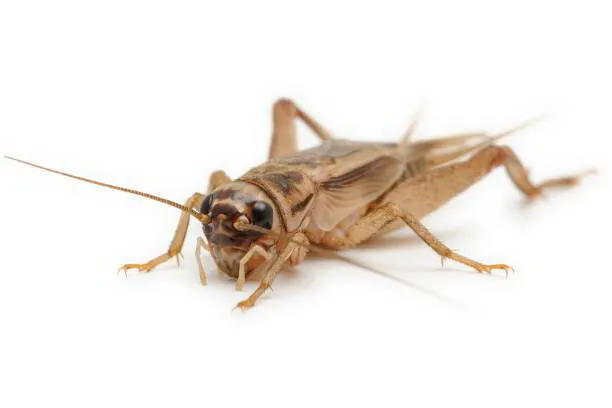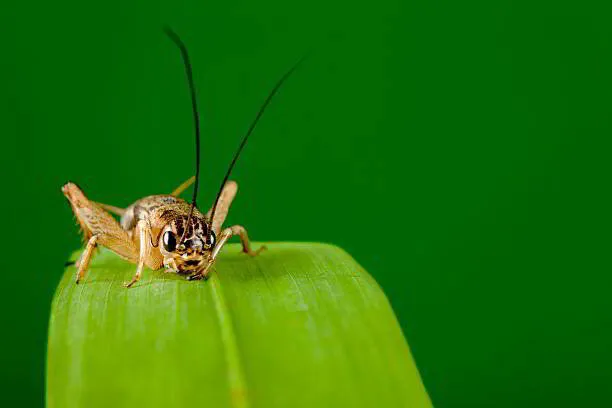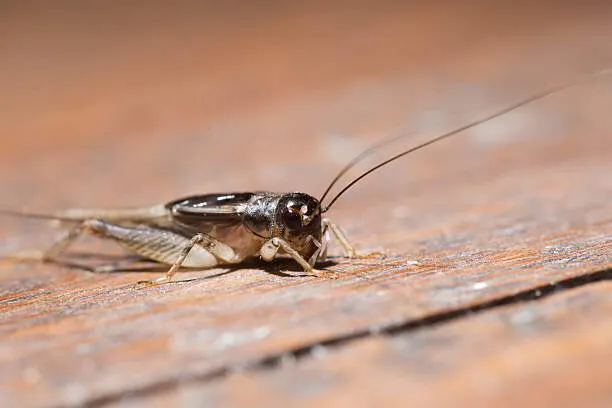What are Crickets?
As their appearance will likely tell you, crickets are related to grasshoppers and katydids. Crickets are medium to large-sized insects and are common invaders of our yards, gardens, and homes. They are identified by their rounded heads, long thin antennae, and wings that are bent down at an angle and rest on the sides of their body. Crickets also have a body that appears flattened from the top and a back pair of legs that are larger and stronger than the rest of their legs. Their back legs provide them with excellent jumping ability. Crickets come in a variety of colors, including brown, black, and brown. Most, but not all, crickets can create the chirping sound that these insects are well-known for. To create the sound, males rub their specially adapted front wings together.
Are Crickets dangerous?
Crickets certainly aren’t a pest that strikes fear in most people, and are mainly considered nuisance pests. Crickets can enter inside in large numbers, are difficult to get rid of, and their continuous chirping when inside a home can drive anyone mad. When living inside, they can cause some damage. They will chew on and create holes in personal belongings, including clothes, blankets, and rugs. Sometimes crickets also cause damage to potted houseplants.
Why do I have a Cricket problem?
Unfortunately, things naturally found in most of our yards attract crickets like tall grasses, bushes, trees, and flower beds. Since crickets tend to live close to homes, they often seek refuge inside them to escape hot, dry weather or cold temperatures. Crickets move inside through spaces they find under basements doors, cracks in the foundation, vents, or areas around wires or other utilities entering into your house.
Where will I find Crickets?
Outside, crickets live in a variety of habitats, including fields, meadows, caves, rock piles, yards, wooded areas, and gardens. Crickets seek moisture and prefer to live in areas of high humidity. If crickets have moved into your home, they will gather in areas that mimic their outdoor environment like basements, crawl spaces, closets, and walls voids. They also sometimes live in the soil of potted plants.
How do I get rid of Crickets?
Getting rid of crickets from your yard, home, or business is best left up to a professional. The professionals here at Amco Pest Solutions will provide you with the year-round solutions needed to get rid of crickets and prevent them from returning. Whether you are looking to get rid of a current cricket infestation or avoid future problems with them, our family owned and operated company is here to help.
Our professionals are committed to providing the pest control services needed to help home and business owners keep their properties free of crickets and other common pests. Amco Pest Solutions offers residential pest control and commercial pest control services throughout New Jersey, the five boroughs of New York, and South Florida. Reach out today to learn more about our effective cricket control solutions!
Discover our control prevention services for more information.
How can I prevent Crickets in the future?
Sealing Entry Points
Identify and seal any cracks, gaps, or openings in your home's exterior, including doors, windows, and foundation areas. Crickets can easily enter through small openings, so thorough sealing is crucial for prevention.
Reduce Outdoor Lighting
Crickets are attracted to bright lights. Consider using yellow-toned or sodium vapor outdoor lights, as they are less attractive to crickets. Additionally, minimize the use of unnecessary lighting around your property, especially during the nighttime.
Keep the Yard Tidy
Crickets are drawn to clutter and tall grass. Keep your yard well-maintained by regularly mowing the lawn, trimming vegetation, and removing debris. A clean and tidy yard reduces hiding places and breeding grounds for crickets.
Limit Moisture
Crickets thrive in damp environments. Address any water leaks or standing water issues around your home. Ensure proper drainage, fix leaks promptly, and consider using dehumidifiers in basements or other damp areas.
Use Natural Repellents
Employ natural repellents, such as diatomaceous earth, around entry points and areas prone to cricket activity. Diatomaceous earth is a non-toxic substance that can help deter and control cricket populations without harming pets or humans.
Apply Insecticides as a Last Resort
If preventive measures are not sufficient, consider using insecticides labeled for cricket control. Apply them according to product instructions and focus on perimeter treatments. However, using chemical control should be a last resort after exhausting non-toxic and preventive measures.
Crickets in Focus: Quick Insights with Amco Pest Solutions
Join us for a quick exploration into the world of crickets! In under a minute, unravel the habits, identification tips, and effective solutions to maintain a cricket-free home. Get quick insights on coexisting peacefully with these chirping companions. Watch now for essential tips on dealing with crickets with Amco Pest Solutions!
Discover The World Of Crickets
Explore and learn about the ecology, diversity, and mystery of Crickets
Our team employs safe, effective strategies to control cricket populations, reducing the annoyance and potential damage they cause indoors and outdoors.
Understanding cricket behavior, including their attraction to light and the chirping males produce, is key to managing their presence effectively.
Key measures include sealing entry points, reducing outdoor lighting, and maintaining a clean environment to discourage cricket infestations.
What are Crickets?
As their appearance will likely tell you, crickets are related to grasshoppers and katydids. Crickets are medium to large-sized insects and are common invaders of our yards, gardens, and homes. They are identified by their rounded heads, long thin antennae, and wings that are bent down at an angle and rest on the sides of their body. Crickets also have a body that appears flattened from the top and a back pair of legs that are larger and stronger than the rest of their legs. Their back legs provide them with excellent jumping ability. Crickets come in a variety of colors, including brown, black, and brown. Most, but not all, crickets can create the chirping sound that these insects are well-known for. To create the sound, males rub their specially adapted front wings together.
Are Crickets dangerous?
Crickets certainly aren’t a pest that strikes fear in most people, and are mainly considered nuisance pests. Crickets can enter inside in large numbers, are difficult to get rid of, and their continuous chirping when inside a home can drive anyone mad. When living inside, they can cause some damage. They will chew on and create holes in personal belongings, including clothes, blankets, and rugs. Sometimes crickets also cause damage to potted houseplants.
Why do I have a Cricket problem?
Unfortunately, things naturally found in most of our yards attract crickets like tall grasses, bushes, trees, and flower beds. Since crickets tend to live close to homes, they often seek refuge inside them to escape hot, dry weather or cold temperatures. Crickets move inside through spaces they find under basements doors, cracks in the foundation, vents, or areas around wires or other utilities entering into your house.
Where will I find Crickets?
Outside, crickets live in a variety of habitats, including fields, meadows, caves, rock piles, yards, wooded areas, and gardens. Crickets seek moisture and prefer to live in areas of high humidity. If crickets have moved into your home, they will gather in areas that mimic their outdoor environment like basements, crawl spaces, closets, and walls voids. They also sometimes live in the soil of potted plants.
How do I get rid of Crickets?
Getting rid of crickets from your yard, home, or business is best left up to a professional. The professionals here at Amco Pest Solutions will provide you with the year-round solutions needed to get rid of crickets and prevent them from returning. Whether you are looking to get rid of a current cricket infestation or avoid future problems with them, our family owned and operated company is here to help.
Our professionals are committed to providing the pest control services needed to help home and business owners keep their properties free of crickets and other common pests. Amco Pest Solutions offers residential pest control and commercial pest control services throughout New Jersey, the five boroughs of New York, and South Florida. Reach out today to learn more about our effective cricket control solutions!
Cricket Behavior and Adaptation
Crickets are known for their chirping sounds, produced by males to attract females. They exhibit nocturnal behavior, hiding during the day and becoming active at night to feed and mate. Their adaptation to various environments is facilitated by their omnivorous diet, consuming both plant material and other insects. Crickets' ability to thrive in diverse habitats underscores their resilience and adaptability.
Lifecycle and Reproduction
Crickets go through a simple lifecycle starting from egg to nymph and finally to adult. Females lay eggs in the soil, which hatch into nymphs resembling miniature adults. These nymphs undergo several molts before reaching maturity. This lifecycle allows crickets to produce multiple generations in a year, depending on environmental conditions, highlighting their reproductive efficiency and ability to quickly populate various ecosystems.
Crickets and Their Role in Ecosystems
Crickets play significant roles in ecosystems as both prey and predators. They help in the decomposition of plant material and the control of smaller insect populations. Their presence is beneficial for soil health and as a food source for various animals, contributing to the biodiversity and balance of ecosystems. Crickets also engage in pollination, further supporting the health of plant communities.
Managing Cricket Populations
Managing cricket populations involves reducing attractants such as excessive moisture and outdoor lighting. Sealing entry points can prevent crickets from entering homes. In gardens, encouraging natural predators like birds can help control cricket numbers. Understanding and tolerating crickets' presence is encouraged due to their ecological benefits, with interventions focused on minimizing their impact on human habitats while conserving their positive roles in nature.
How can I prevent Crickets in the future?
Sealing Entry Points
Identify and seal any cracks, gaps, or openings in your home's exterior, including doors, windows, and foundation areas. Crickets can easily enter through small openings, so thorough sealing is crucial for prevention.
Reduce Outdoor Lighting
Crickets are attracted to bright lights. Consider using yellow-toned or sodium vapor outdoor lights, as they are less attractive to crickets. Additionally, minimize the use of unnecessary lighting around your property, especially during the nighttime.
Keep the Yard Tidy
Crickets are drawn to clutter and tall grass. Keep your yard well-maintained by regularly mowing the lawn, trimming vegetation, and removing debris. A clean and tidy yard reduces hiding places and breeding grounds for crickets.
Limit Moisture
Crickets thrive in damp environments. Address any water leaks or standing water issues around your home. Ensure proper drainage, fix leaks promptly, and consider using dehumidifiers in basements or other damp areas.
Use Natural Repellents
Employ natural repellents, such as diatomaceous earth, around entry points and areas prone to cricket activity. Diatomaceous earth is a non-toxic substance that can help deter and control cricket populations without harming pets or humans.
Apply Insecticides as a Last Resort
If preventive measures are not sufficient, consider using insecticides labeled for cricket control. Apply them according to product instructions and focus on perimeter treatments. However, using chemical control should be a last resort after exhausting non-toxic and preventive measures.
Discover More Pests & Rodents Below!
Crickets in Focus: Quick Insights with Amco Pest Solutions
Join us for a quick exploration into the world of crickets! In under a minute, unravel the habits, identification tips, and effective solutions to maintain a cricket-free home. Get quick insights on coexisting peacefully with these chirping companions. Watch now for essential tips on dealing with crickets with Amco Pest Solutions!



